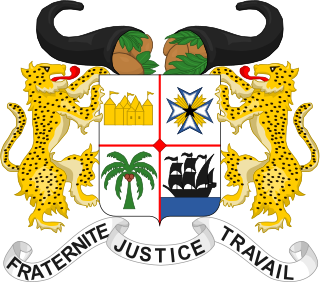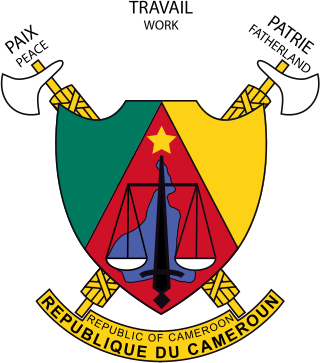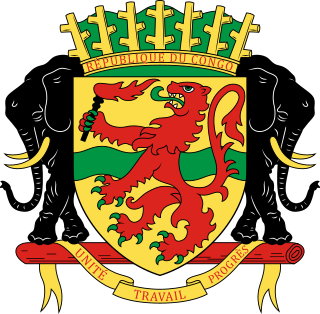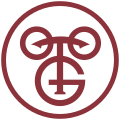
The coat of arms of South Africa is the main heraldic insignia of South Africa. The present coat of arms was introduced on Freedom Day, 27 April 2000, and was designed by Iaan Bekker. It replaced the earlier national arms, which had been in use since 1910. The motto is written in the extinct ǀXam, member of the Khoisan languages, and translates literally to "diverse people unite". The previous motto, in Latin, was Ex Unitate Vires, translated as "From unity, strength".

The coat of arms of the province of Quebec was adopted by order-in-council of the Government of Quebec on 9 December 1939, replacing the arms assigned by royal warrant of Queen Victoria on 26 May 1868.

The coat of arms or national seal of Benin, originally introduced in 1964, was readopted in 1990 after being replaced in 1975.

The national flag of Togo consists of five horizontal stripes, alternating between green and yellow, with a red square bearing a five-pointed white star in the canton. It is one of many African flags that use the pan-African colours of green, yellow, and red. It was designed by Togolese artist Paul Ahyi in 1960, just before its adoption on 27 April of that year, coinciding with Togo's proclamation of independence. When Togo was an autonomous republic within the French Union, it flew a green flag with the French tricolour in the canton and two five-pointed yellow stars, one in the lower hoist and one in the upper fly.

The coat of arms of Burkina Faso contains a shield based on the national flag. Above the shield the name of the country is shown, while below it is the national motto, Unité, Progrès, Justice. The supporters are two white stallions. The two plants emerging from the lower banner appear to represent pearl millet, an important cereal grain cultivated in this country where agriculture represents 32% of the gross domestic product. This coat of arms is similar to the old Upper Volta coat of arms, with the Burkina Faso flag replacing the Upper Volta flag in the middle. The coat of arms and its meaning is mandated by Law No 020/97/II/AN.

The coat of arms of Bulgaria consists of a crowned golden lion rampant over a dark red shield; above the shield is the Bulgarian historical crown. The shield is supported by two crowned golden lions rampant; below the shield there is compartment in the shape of oak twigs and white bands with the national motto "Unity makes strength" inscribed on them.

The coat of arms of Cameroon consists of a shield with a banner above and below it. Behind the shield are two crossed fasces. The shield has the same color pattern as the flag of Cameroon, and in the center is a map of the nation. The scales of justice are superimposed on top of the map of the nation since 1984.

The coat of arms of Chad was adopted in 1970. The center has a shield with jagged blue and yellow lines, with a sun rising over it. The shield is supported by a goat and a lion. Below the shield is a medal and a scroll with the national motto in French, Unité, Travail, Progrès. The shield supporters as well as the scroll feature a red arrow pointing upwards.

The coat of arms of the Republic of the Congo has a shield with a rampant red lion holding a torch. The background color of the shield is gold with a green, wavy, horizontal stripe along the middle. A golden crown sits above the shield. Two large African war elephants support the shield. A banner with the national motto "Unité Travail Progrès" is draped from a bar supporting the war elephants. The arms were adopted in 1960 and readopted in 1991 after having been replaced with a simpler, unheraldic symbol during the People's Republic of the Congo era from 1970–1991.

The coat of arms of Germany displays a black eagle with a red beak, a red tongue and red feet on a golden field, which is blazoned: Or, an eagle displayed sable beaked langued and membered gules. This is the Bundesadler, formerly known as Reichsadler. It is one of the oldest coats of arms in the world, and today the oldest national symbol used in Europe.

The coat of arms of Ukraine is a blue shield with a golden trident. It is colloquially known as the tryzub.

The national emblem of East Timor is one of the national symbols of East Timor.

The coat of arms of Haiti is the national coat of arms of the Republic of Haiti. It was originally introduced in 1807, and it has appeared in its current form since 1986. Since this Haitian national symbol does not conform to the rules of heraldry for a traditional coat of arms, then it could be considered a national emblem instead.

The coat of arms of Niger shows a trophy of four national flags, in the colors orange, white, and green. In the middle, the state seal is arranged. On a green or gold shield the four golden symbols are shown. In the middle, there is a sun, to the left there is a vertical spear with two crossed Tuareg swords, to the right are three pearl millet heads and underneath is the frontal view of a zebu head. Under the coat of arms, there is a ribbon bearing the name of the country in French: Republique du Niger. While the constitution of Niger stipulates the color of the symbols upon the shield, there is no uniformity on the color of the shield. The 1999 Constitution reproduces the text of earlier constitutions, making a distinction between the Seal of State for which no shield colour is stipulated and the Coat of Arms of the Republic for which Sinople is stipulated as the shield colour. Sinople is analogous to Vert (Green) in heraldry, but official buildings and documents do not display green shields. Embassies and official documents use white, with gold emblems. The website of the President of Niger uses gold or yellow with dark gold or black emblems. The National Assembly of Niger meets below a large coat of arms with the shield coloured gold and the emblems in a darker gold.

The Emblem of the Turkmen Soviet Socialist Republic was adopted on 2 March 1937 by the government of the Turkmen Soviet Socialist Republic. The coat of arms is based on the coat of arms of the Soviet Union. It shows symbols of agriculture and heavy industry, as well as a symbol of the Turkmen people, a rug. The rising Sun stands for the future of the Turkmen nation, the red star as well as the hammer and sickle for the victory of Communism and the "world-wide socialist community of states".
This is a list of coats of arms of Germany.

The coat of arms of the German state and city of Hamburg is a kind of national emblem. The coat of arms and the flags are regulated by the constitution of Hamburg and law. The colors of Hamburg are white and red. One of the oldest versions of the castle is found on a seal in 1241.

The national emblem of North Macedonia depicts two curved garlands of sheaves of wheat, tobacco leaves and opium poppy fruits, tied by a ribbon decorated with embroidery of traditional Macedonian folk motifs. In the center of the ovoid frame are depicted a mountain, a lake and a sunrise. The features of the national coat of arms contain a rising sun which symbolizes freedom, the Šar Mountains with its peak named Ljuboten or Mount Korab and the river Vardar, with Lake Ohrid. The emblem also contains opium poppy fruits; this poppy was brought to the area during Ottoman times in the first half of the 19th century. Until 16 November 2009, the emblem also depicted a socialistic five-pointed star in the top. This emblem had been in use since 1946, shortly after the republic became part of Yugoslavia.
A national coat of arms is a symbol which denotes an independent state in the form of a heraldic achievement. While a national flag is usually used by the population at large and is flown outside and on ships, a national coat of arms is normally considered a symbol of the government or the head of state personally and tends to be used in print, on armorial ware, and as a wall decoration in official buildings. The royal arms of a monarchy, which may be identical to the national arms, are sometimes described as arms of dominion or arms of sovereignty.

The coat of arms and flag that serve as the symbols of the Police County, in West Pomeranian Voivodeship, Poland were established on 28 June 2000. They were designed by Radosław Gaziński.




















